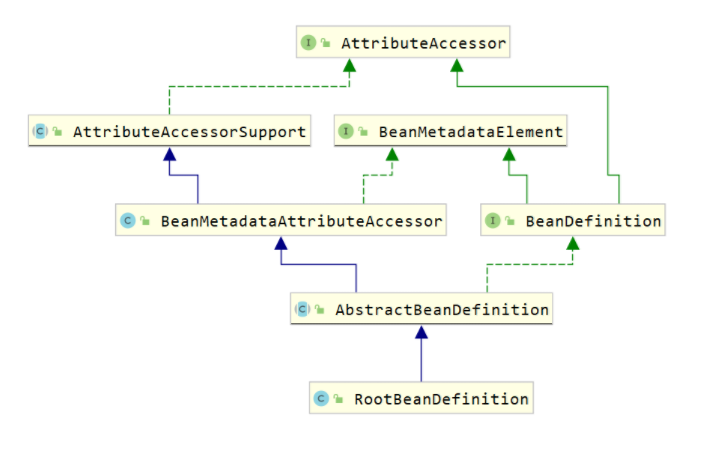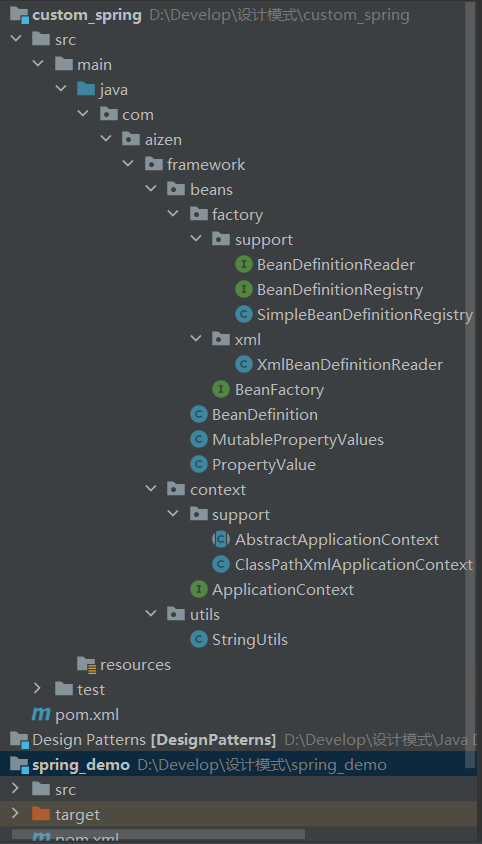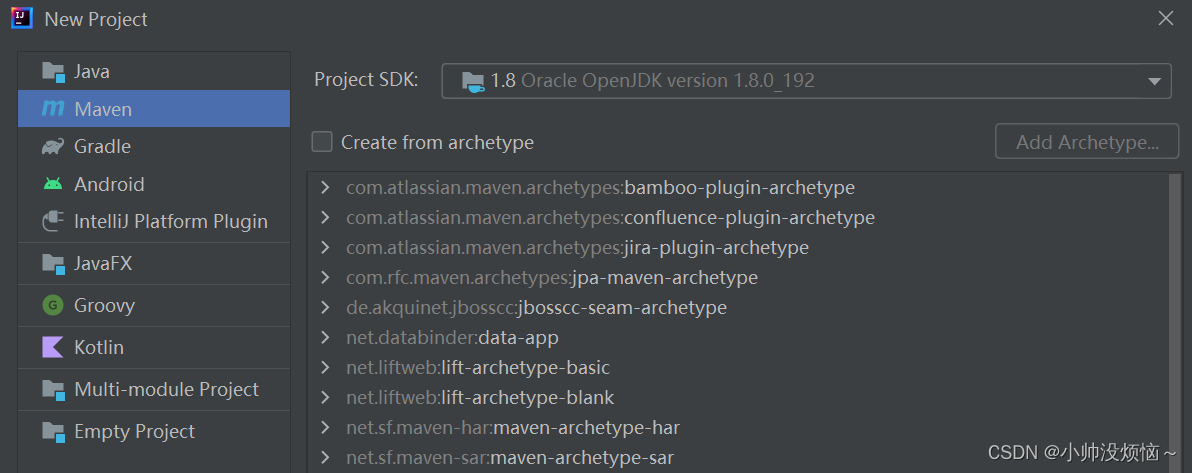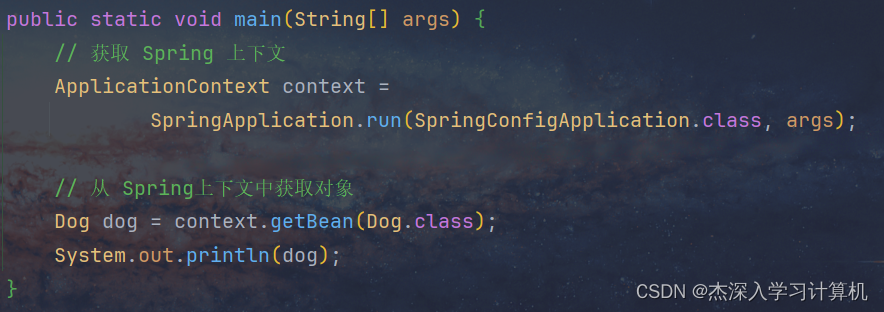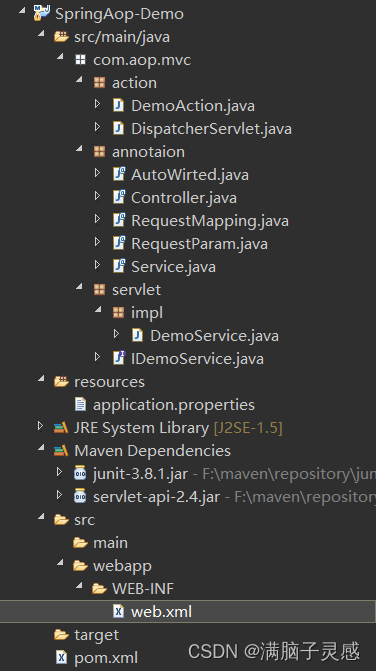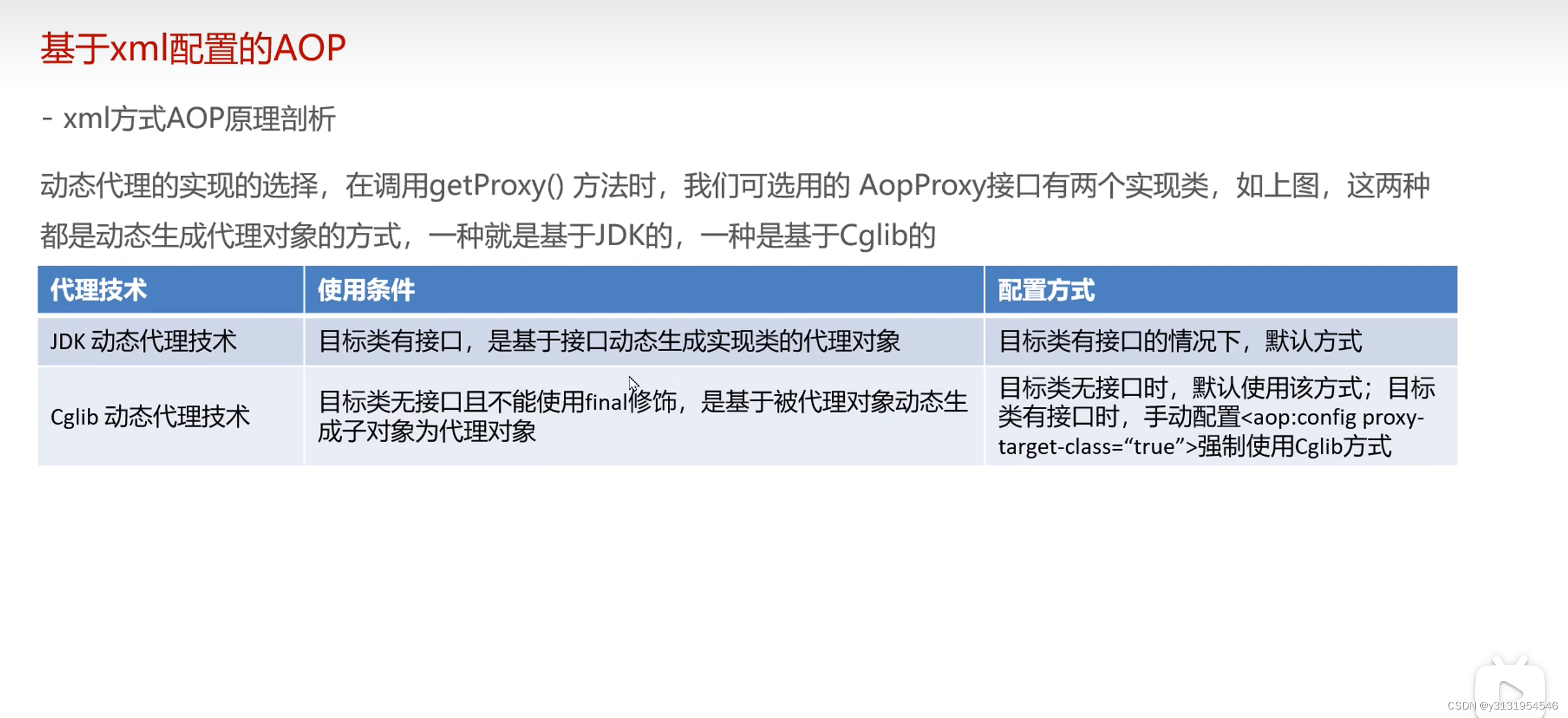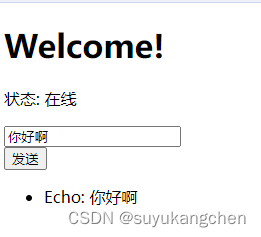文章目录
⭐⭐⭐Spring核心源码分析+自定义Spring框架⭐⭐⭐
学习完这个篇章以后,【23种设计模式·全精解析】至此完结。相信手写完这个自定义Spring框架后,你可以对Spring的核心底层有更深的认识,并学会设计模式在具体实际开发中的如何去灵活应用!
一、Spring使用回顾
自定义spring框架前,先回顾一下spring框架的使用,从而分析spring的核心,并对核心功能进行模拟。
// 数据访问层接口
public interface UserDao {
void add();
}
// 数据访问层实现类
public class UserDaoImpl implements UserDao {
@Override
public void add() {
System.out.println("UserDao...");
}
}
// 业务逻辑层接口
public interface UserService {
void add();
}
// 业务逻辑层实现类
public class UserServiceImpl implements UserService {
// 声明一个UserDao类型的变量
private UserDao userDao;
// 通过Spring依赖注入进行赋值
public void setUserDao(UserDao userDao) {
this.userDao = userDao;
}
@Override
public void add() {
System.out.println("UserService...");
userDao.add();
}
}
import com.aizen.service.UserService;
import org.springframework.context.ApplicationContext;
import org.springframework.context.support.ClassPathXmlApplicationContext;
// 控制层
public class UserController {
public static void main(String[] args) {
// 创建Spring的容器对象(非延时加载)
ApplicationContext applicationContext = new ClassPathXmlApplicationContext("applicationContext.xml");
// 从ioc容器对象中获取userService对象
UserService userService = applicationContext.getBean("userService", UserService.class);
//调用userService方法进行业务逻辑处理
userService.add();
}
}
<?xml version="1.0" encoding="UTF-8"?>
<beans xmlns:xsi="http://www.w3.org/2001/XMLSchema-instance"
xmlns="http://www.springframework.org/schema/beans"
xmlns:context="http://www.springframework.org/schema/context"
xsi:schemaLocation="http://www.springframework.org/schema/beans
http://www.springframework.org/schema/beans/spring-beans.xsd
http://www.springframework.org/schema/context
http://www.springframework.org/schema/context/spring-context.xsd">
<bean id="userDao" class="com.aizen.dao.impl.UserDaoImpl"/><!-- IOC容器管理对象 -->
<bean id="userService" class="com.aizen.service.impl.UserServiceImpl">
<property name="userDao" ref="userDao"/><!-- 依赖注入DI -->
</bean>
</beans>
- userService对象是从applicationContext容器对象获取到的,也就是userService对象交由spring进行管理。
- 上面结果可以看到调用了UserDao对象中的add方法,也就是说UserDao子实现类对象也交由spring管理了。
- UserService中的userDao变量我们并没有进行赋值,但是可以正常使用,说明spring已经将UserDao对象赋值给了userDao变量。
上面三点体现了Spring框架的IOC(Inversion of Control)和DI(Dependency Injection, DI)
二、Spring核心功能结构
1、Spring核心功能
Spring大约有20个模块,由1300多个不同的文件构成。这些模块可以分为:核心容器、AOP和设备支持、数据访问与集成、Web组件、通信报文和集成测试等,下面是 Spring 框架的总体架构图: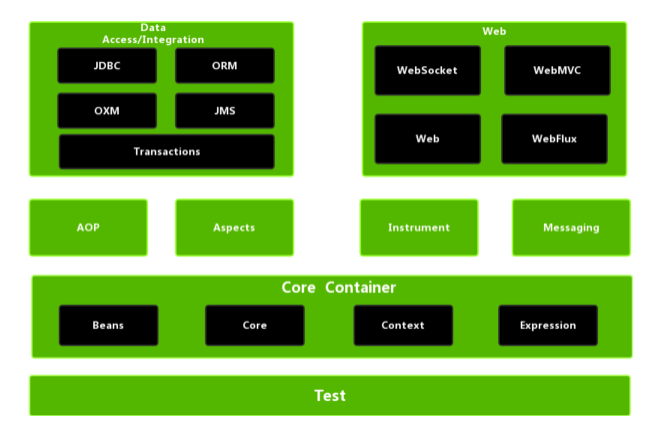
核心容器由 beans、core、context 和 expression(Spring Expression Language,SpEL)4个模块组成。
- spring-beans和spring-core模块是Spring框架的核心模块,包含了
控制反转(Inversion of Control,IOC)和依赖注入(Dependency Injection,DI)。BeanFactory使用控制反转对应用程序的配置和依赖性规范与实际的应用程序代码进行了分离。BeanFactory属于延时加载,也就是说在实例化容器对象后并不会自动实例化Bean,只有当Bean被使用时,BeanFactory才会对该 Bean 进行实例化与依赖关系的装配。
// 延时加载示例
BeanFactory beanFactory = new XmlBeanFactory(new ClassPathResource("applicationContext.xml"));
// 执行完getBean方法ioc容器才会创建service和dao对象,并绑定依赖关系
UserService userService = beanFactory.getBean("userService", UserService.class);
userService.add();
- spring-context模块构架于核心模块之上,扩展了BeanFactory,为它添加了Bean生命周期控制、框架事件体系及资源加载透明化等功能。此外,该模块还提供了许多企业级支持,如邮件访问、远程访问、任务调度等,ApplicationContext 是该模块的核心接口,它的超类是 BeanFactory。与BeanFactory不同,ApplicationContext实例化后会自动对所有的单实例Bean进行实例化与依赖关系的装配,使之处于待用状态。
- spring-context-support模块是对Spring IoC容器及IoC子容器的扩展支持。
- spring-context-indexer模块是Spring的类管理组件和Classpath扫描组件。
- spring-expression 模块是统一表达式语言(EL)的扩展模块,可以查询、管理运行中的对象,同时也可以方便地调用对象方法,以及操作数组、集合等。它的语法类似于传统EL,但提供了额外的功能,最出色的要数函数调用和简单字符串的模板函数。EL的特性是基于Spring产品的需求而设计的,可以非常方便地同Spring IoC进行交互。
2、bean概述
Spring 就是面向 Bean 的编程(BOP ,Bean Oriented Programming),Bean 在 Spring 中处于核心地位。Bean对于Spring的意义就像Object对于OOP的意义一样,Spring中没有Bean也就没有Spring存在的意义。Spring IoC容器通过配置文件或者注解的方式来管理bean对象之间的依赖关系。
<bean id="userDao" class="com.itheima.dao.impl.UserDaoImpl"></bean>
<bean id="userService" class="com.itheima.service.impl.UserServiceImpl">
<property name="userDao" ref="userDao"></property>
</bean>
为什么Bean如此重要呢?
三、Spring IOC相关接口分析
1、BeanFactory解析
Spring中Bean的创建是典型的工厂模式,这一系列的Bean工厂,即IoC容器,为开发者管理对象之间的依赖关系提供了很多便利和基础服务,在Spring中有许多IoC容器的实现供用户选择,其相互关系如下图所示。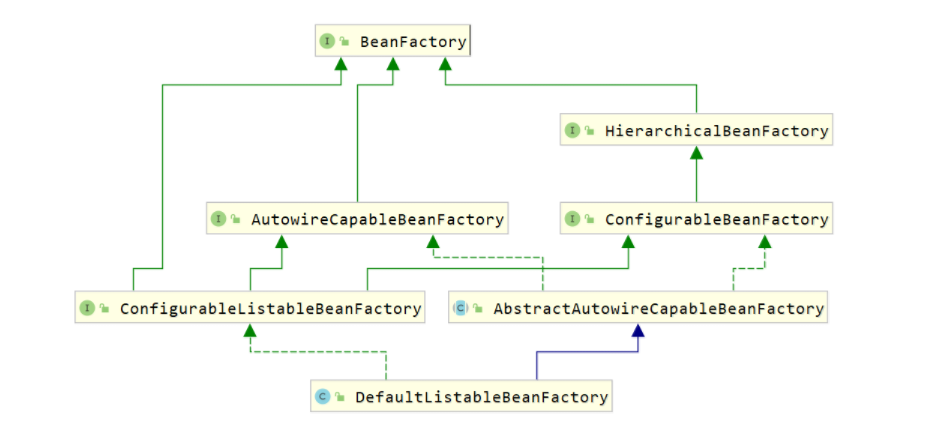
其中,BeanFactory作为最顶层的一个接口,定义了IoC容器的基本功能规范,BeanFactory有三个重要的子接口:ListableBeanFactory、HierarchicalBeanFactory和AutowireCapableBeanFactory。但是从类图中我们可以发现最终的默认实现类是DefaultListableBeanFactory,它实现了所有的接口。
那么为何要定义这么多层次的接口呢?
每个接口都有它的使用场合,主要是为了区分在Spring内部操作过程中对象的传递和转化,对对象的数据访问所做的限制。例如:
这三个接口共同定义了Bean的集合、Bean之间的关系及Bean行为。最基本的IoC容器接口是BeanFactory,来看一下它的源码:
public interface BeanFactory {
String FACTORY_BEAN_PREFIX = "&";
// 根据bean的名称获取IOC容器中的的bean对象
Object getBean(String name) throws BeansException;
// 根据bean的名称获取IOC容器中的的bean对象,并指定获取到的bean对象的类型,这样我们使用时就不需要进行类型强转了
<T> T getBean(String name, Class<T> requiredType) throws BeansException;
Object getBean(String name, Object... args) throws BeansException;
<T> T getBean(Class<T> requiredType) throws BeansException;
<T> T getBean(Class<T> requiredType, Object... args) throws BeansException;
<T> ObjectProvider<T> getBeanProvider(Class<T> requiredType);
<T> ObjectProvider<T> getBeanProvider(ResolvableType requiredType);
// 判断容器中是否包含指定名称的bean对象
boolean containsBean(String name);
// 根据bean的名称判断是否是单例
boolean isSingleton(String name) throws NoSuchBeanDefinitionException;
boolean isPrototype(String name) throws NoSuchBeanDefinitionException;
boolean isTypeMatch(String name, ResolvableType typeToMatch) throws NoSuchBeanDefinitionException;
boolean isTypeMatch(String name, Class<?> typeToMatch) throws NoSuchBeanDefinitionException;
@Nullable
Class<?> getType(String name) throws NoSuchBeanDefinitionException;
String[] getAliases(String name);
}
在BeanFactory里只对IoC容器的基本行为做了定义,根本不关心Bean是如何定义及怎样加载的。
正如我们只关心能从工厂里得到什么产品,不关心工厂是怎么生产这些产品的。
具体如何创建交给该接口的具体子实现类去实现。
BeanFactory有一个很重要的子接口,就是ApplicationContext接口,该接口主要来规范容器中的bean对象是非延时加载,即在创建容器对象的时候就对象bean进行初始化,并存储到一个容器中。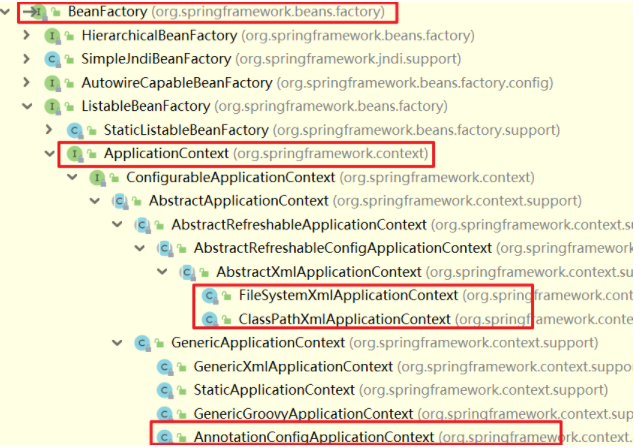
要知道工厂是如何产生对象的,我们需要看具体的IoC容器实现,Spring提供了许多IoC容器实现,比如:
2、BeanDefinition解析
Spring IoC容器管理我们定义的各种Bean对象及其相互关系,而Bean对象在Spring实现中是以BeanDefinition来描述的,如下面配置文件:
<bean id="userDao" class="com.itheima.dao.impl.UserDaoImpl"></bean>
bean标签还有很多属性:
scope、init-method、destory-method等。
Spring要解析这些bean标签,必然要把这些bean标签对应属性的值进行一个封装,而封装成的对象就是BeanDefinition对象,而BeanDefinition是一个接口,所以Spring封装的是BeanDefinition的子实现类对象。
3、BeanDefinitionReader解析
Bean的解析过程非常复杂,功能被分得很细,因为这里需要被扩展的地方很多,必须保证足够的灵活性,以应对可能的变化。Bean的解析主要就是对Spring配置文件的解析。这个解析过程主要通过BeanDefinitionReader来完成,看看Spring中BeanDefinitionReader的类结构图(部分),如下图所示。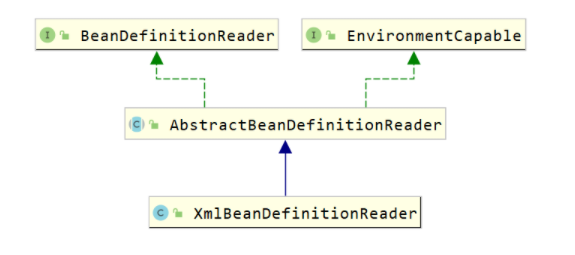
看看BeanDefinitionReader接口定义的功能来理解它具体的作用:
public interface BeanDefinitionReader {
// 获取BeanDefinitionRegistry注册器对象
BeanDefinitionRegistry getRegistry();
@Nullable
ResourceLoader getResourceLoader();
@Nullable
ClassLoader getBeanClassLoader();
BeanNameGenerator getBeanNameGenerator();
/*
下面的loadBeanDefinitions都是加载bean定义,从指定的资源中获取
如String类型的字符冲路径,Resource对象类型
*/
int loadBeanDefinitions(Resource resource) throws BeanDefinitionStoreException;
int loadBeanDefinitions(Resource... resources) throws BeanDefinitionStoreException;
int loadBeanDefinitions(String location) throws BeanDefinitionStoreException;
int loadBeanDefinitions(String... locations) throws BeanDefinitionStoreException;
}
4、BeanDefinitionRegistry解析
BeanDefinitionReader用来解析bean定义,并封装BeanDefinition对象,而我们定义的配置文件中定义了很多bean标签,所以就有一个问题,解析的多个BeanDefinition对象存储到哪儿?答案就是BeanDefinition的注册中心,而该注册中心顶层接口就是BeanDefinitionRegistry。
public interface BeanDefinitionRegistry extends AliasRegistry {
// 往注册表中注册bean
void registerBeanDefinition(String beanName, BeanDefinition beanDefinition) throws BeanDefinitionStoreException;
// 从注册表中删除指定名称的bean
void removeBeanDefinition(String beanName) throws NoSuchBeanDefinitionException;
// 获取注册表中指定名称的bean
BeanDefinition getBeanDefinition(String beanName) throws NoSuchBeanDefinitionException;
// 判断注册表中是否已经注册了指定名称的bean
boolean containsBeanDefinition(String beanName);
// 获取注册表中所有的bean的名称
String[] getBeanDefinitionNames();
int getBeanDefinitionCount();
boolean isBeanNameInUse(String beanName);
}
继承结构图如下(部分):
从上面类图可以看到BeanDefinitionRegistry接口的子实现类主要有以下几个:
- DefaultListableBeanFactory
在该类中定义了如下代码,就是用来注册bean - Map<String, BeanDefinition>:键是BeanDefinition的名称,值是BeanDefinition对象
private final Map<String, BeanDefinition> beanDefinitionMap = new ConcurrentHashMap<>(256);
- SimpleBeanDefinitionRegistry
在该类中定义了如下代码,就是用来注册bean - Map<String, BeanDefinition>:键是BeanDefinition的名称,值是BeanDefinition对象
private final Map<String, BeanDefinition> beanDefinitionMap = new ConcurrentHashMap<>(64);
5、创建容器


- 它对 Bean 配置资源进行载入,ClassPathXmlApplicationContext通过调用其父类AbstractApplicationContext的refresh()方法启动整个IoC容器对Bean定义的载入过程。

四、自定义SpringIOC
现要对下面的配置文件进行解析,并自定义Spring框架的IOC对涉及到的对象进行管理。
<?xml version="1.0" encoding="UTF-8"?>
<beans>
<bean id="userService" class="com.itheima.service.impl.UserServiceImpl">
<property name="userDao" ref="userDao"></property>
</bean>
<bean id="userDao" class="com.itheima.dao.impl.UserDaoImpl"></bean>
</beans>
1、定义bean相关的pojo类
(1)PropertyValue类
用于封装bean的属性,体现到上面的配置文件就是封装bean标签的子标签property标签数据。
// 用来封装bean标签下的property标签的属性
public class PropertyValue {
private String name;
private String ref;
private String value; // 赋值的属性为:基本数据类型及String类型数据
public PropertyValue() {
}
public PropertyValue(String name, String ref, String value) {
this.name = name;
this.ref = ref;
this.value = value;
}
public String getName() {
return name;
}
public void setName(String name) {
this.name = name;
}
public String getRef() {
return ref;
}
public void setRef(String ref) {
this.ref = ref;
}
public String getValue() {
return value;
}
public void setValue(String value) {
this.value = value;
}
}
(2)MutablePropertyValues类
一个bean标签可以有多个property子标签,所以再定义一个MutablePropertyValues类,用来存储并管理多个PropertyValue对象。
import java.util.ArrayList;
import java.util.Iterator;
import java.util.List;
// 用户存储和管理多个PropertyValue对象
public class MutablePropertyValues implements Iterable<PropertyValue> {
// 定义List集合对象,用来存储PropertyValue对象
private final List<PropertyValue> propertyValueList;
public MutablePropertyValues() {
this.propertyValueList = new ArrayList<PropertyValue>();
}
public MutablePropertyValues(List<PropertyValue> propertyValueList) {
this.propertyValueList = (propertyValueList != null ? propertyValueList : new ArrayList<PropertyValue>());
}
// 获取所有的PropertyValue对象,返回以数组的形式
public PropertyValue[] getPropertyValues() {
// 将集合转换为数组并返回
return propertyValueList.toArray(new PropertyValue[0]); // 参数指定返回数组的类型
}
// 根据name属性值名称获取对应的PropertyValue对象
public PropertyValue getPropertyValue(String propertyName) {
// 遍历集合对象
for (PropertyValue pv : propertyValueList) {
if (pv.getName().equals(propertyName)) {
return pv;
}
}
return null;
}
// 判断集合是否为空
public boolean isEmpty() {
return propertyValueList.isEmpty();
}
// 添加PropertyValue对象
public MutablePropertyValues addPropertyValue(PropertyValue pv) {
// 遍历并判断集合中存储的PropertyValue对象是否和传递进来的pv重复了
for (int i = 0; i < propertyValueList.size(); i++) {
// 获取集合中每一个PropertyValue对象
PropertyValue currentPv = propertyValueList.get(i);
// 如果重复了,进行覆盖
if (currentPv.getName().equals(pv.getName())) {
propertyValueList.set(i, pv);
//this.propertyValueList.set(i, new PropertyValue(pv.getName(), pv.getRef(), pv.getValue()));
return this; // 目的是实现链式编程
}
}
// 遍历完说明没有重复的
this.propertyValueList.add(pv);
return this; // 目的是实现链式编程
}
// 判断是否有指定name属性值的对象
public boolean contains(String propertyName) {
// 如果不等于null说明包含该name的PropertyValue,返回true;如果等于null说明不包含,返回false;
return getPropertyValue(propertyName) != null;
}
// 获取迭代器对象
@Override
public Iterator<PropertyValue> iterator() {
return propertyValueList.iterator();
}
}
(3)BeanDefinition类
BeanDefinition类用来封装bean信息的,主要包含id(即bean对象的名称)、class(需要交由spring管理的类的全类名)及子标签property数据。
// 用来封装bean标签数据
public class BeanDefinition {
private String id;
private String className;
private MutablePropertyValues propertyValues; // property子标签的数据
public BeanDefinition() {
propertyValues = new MutablePropertyValues();
}
public String getId() {
return id;
}
public void setId(String id) {
this.id = id;
}
public String getClassName() {
return className;
}
public void setClassName(String className) {
this.className = className;
}
public MutablePropertyValues getPropertyValues() {
return propertyValues;
}
public void setPropertyValues(MutablePropertyValues propertyValues) {
this.propertyValues = propertyValues;
}
}
2、定义注册表相关类
(1)BeanDefinitionRegistry接口
BeanDefinitionRegistry接口定义了注册表的相关操作,定义如下功能:
- 注册BeanDefinition对象到注册表中
- 从注册表中删除指定名称的BeanDefinition对象
- 根据名称从注册表中获取BeanDefinition对象
- 判断注册表中是否包含指定名称的BeanDefinition对象
- 获取注册表中BeanDefinition对象的个数
- 获取注册表中所有的BeanDefinition的名称
import com.aizen.framework.beans.BeanDefinition;
// 注册表接口
public interface BeanDefinitionRegistry {
// 注册BeanDefinition对象到注册表中
void registerBeanDefinition(String beanName, BeanDefinition beanDefinition);
// 从注册表中删除指定名称的BeanDefinition对象
void removeBeanDefinition(String beanName) throws Exception;
// 根据名称从注册表中获取BeanDefinition对象
BeanDefinition getBeanDefinition(String beanName) throws Exception;
boolean containsBeanDefinition(String beanName);
int getBeanDefinitionCount();
String[] getBeanDefinitionNames();
}
(2)SimpleBeanDefinitionRegistry类
该类实现了BeanDefinitionRegistry接口,定义了Map集合作为注册表容器。
import com.aizen.framework.beans.BeanDefinition;
import java.util.HashMap;
import java.util.Map;
// 注册表接口的子实现类
public class SimpleBeanDefinitionRegistry implements BeanDefinitionRegistry {
// 定义一个容器,用来存储BeanDefinition对象
private Map<String, BeanDefinition> beanDefinitionMap = new HashMap<String, BeanDefinition>();
@Override
public void registerBeanDefinition(String beanName, BeanDefinition beanDefinition) {
beanDefinitionMap.put(beanName,beanDefinition);
}
@Override
public void removeBeanDefinition(String beanName) throws Exception {
beanDefinitionMap.remove(beanName);
}
@Override
public BeanDefinition getBeanDefinition(String beanName) throws Exception {
return beanDefinitionMap.get(beanName);
}
@Override
public boolean containsBeanDefinition(String beanName) {
return beanDefinitionMap.containsKey(beanName);
}
@Override
public int getBeanDefinitionCount() {
return beanDefinitionMap.size();
}
@Override
public String[] getBeanDefinitionNames() {
return beanDefinitionMap.keySet().toArray(new String[0]);
}
}
3、定义解析器相关类
(1)BeanDefinitionReader接口
BeanDefinitionReader是用来解析配置文件并在注册表中注册bean的信息。定义了两个规范:
- 获取注册表的功能,让外界可以通过该对象获取注册表对象。
- 加载配置文件,并注册bean数据。
// 用来解析配置文件的,而该接口只是定义了规范
public interface BeanDefinitionReader {
// 获取注册表对象
BeanDefinitionRegistry getRegistry();
// 加载配置文件并在注册表中进行注册
void loadBeanDefinitions(String configLocation) throws Exception;
}
(2)XmlBeanDefinitionReader类
XmlBeanDefinitionReader类是专门用来解析xml配置文件的。该类实现BeanDefinitionReader接口并实现接口中的两个功能。
引入dom4j依赖坐标:
<!-- dom4j -->
<dependency>
<groupId>dom4j</groupId>
<artifactId>dom4j</artifactId>
<version>1.6.1</version>
</dependency>
import com.aizen.framework.beans.BeanDefinition;
import com.aizen.framework.beans.MutablePropertyValues;
import com.aizen.framework.beans.PropertyValue;
import com.aizen.framework.beans.factory.support.BeanDefinitionReader;
import com.aizen.framework.beans.factory.support.BeanDefinitionRegistry;
import com.aizen.framework.beans.factory.support.SimpleBeanDefinitionRegistry;
import org.dom4j.Document;
import org.dom4j.Element;
import org.dom4j.io.SAXReader;
import java.io.InputStream;
import java.util.List;
// XML解析器:针对XML配置文件进行解析的类,把Bean解析封装为BeanDefinition对象,并注册到注册表中
public class XmlBeanDefinitionReader implements BeanDefinitionReader {
// 声明注册表对象
private BeanDefinitionRegistry registry;
public XmlBeanDefinitionReader() {
registry = new SimpleBeanDefinitionRegistry();
}
@Override
public BeanDefinitionRegistry getRegistry() {
return registry;
}
@Override
public void loadBeanDefinitions(String configLocation) throws Exception {
// 使用dom4j进行xml配置文件的解析
SAXReader reader = new SAXReader();
// 通过输入流,获取类路径下的配置文件
InputStream is = XmlBeanDefinitionReader.class.getClassLoader().getResourceAsStream(configLocation);
Document document = reader.read(is);
// 根据Document对象获取根标签对象(<beans>)
Element rootElement = document.getRootElement();
// 获取根标签下的所有的bean标签对象
List<Element> beanElements = rootElement.elements("bean");
// 遍历所有bean标签集合对象,获取每一个bean
for (Element beanElement : beanElements) {
// 获取bean标签下的id属性,class属性,property属性
String id = beanElement.attributeValue("id");
String className = beanElement.attributeValue("class");
// 将id属性和cLass属性封装到BeanDefinition对家中
BeanDefinition beanDefinition = new BeanDefinition();
beanDefinition.setId(id);
beanDefinition.setClassName(className);
// 获取bean标签下所有的property标签对象
List<Element> propertyElements = beanElement.elements("property");
// 创建MutablePropertyValues对象
MutablePropertyValues propertyValues = new MutablePropertyValues();
for (Element propertyElement : propertyElements) {
// 获取property标签下的name属性,ref属性,value属性
String name = propertyElement.attributeValue("name");
String ref = propertyElement.attributeValue("ref");
String value = propertyElement.attributeValue("value");
// 封装为PropertyValue对象
PropertyValue propertyValue = new PropertyValue(name, ref, value);
propertyValues.addPropertyValue(propertyValue);
}
// 将propertyValues对象封装到beanDefinition对象中
beanDefinition.setPropertyValues(propertyValues);
// 将beanDefinition对象注册到注册表中
registry.registerBeanDefinition(id, beanDefinition);
}
}
}
4、IOC容器相关类
(1)BeanFactory接口
// IOC容器父接口
public interface BeanFactory {
// 根据bean对象的名称获取bean对象
Object getBean(String name) throws Exception;
// 根据bean对象的名称获取bean对象,并进行类型转换
<T> T getBean(String name, Class<? extends T> clazz) throws Exception;
}
(2)ApplicationContext接口
该接口的所以的子实现类对bean对象的创建都是非延时的,所以在该接口中定义 refresh() 方法,该方法主要完成以下两个功能:
- 加载配置文件。
- 根据注册表中的BeanDefinition对象封装的数据进行bean对象的创建。
import com.aizen.framework.beans.factory.BeanFactory;
// 定义非延时加载功能
public interface ApplicationContext extends BeanFactory {
// 进行配置文件加载并进行对象创建
void refresh() throws Exception;
}
(3)AbstractApplicationContext类
- 作为ApplicationContext接口的子类,所以该类也是非延时加载,所以需要在该类中定义一个Map集合,作为bean对象存储的容器。
- 声明BeanDefinitionReader类型的变量,用来进行xml配置文件的解析,符合单一职责原则。
BeanDefinitionReader类型的对象创建交由子类实现,因为只有子类明确到底创建BeanDefinitionReader哪儿个子实现类对象(如解析xml配置文件、properties配置文件)。
import com.aizen.framework.beans.factory.support.BeanDefinitionReader;
import com.aizen.framework.beans.factory.support.BeanDefinitionRegistry;
import com.aizen.framework.context.ApplicationContext;
import java.util.HashMap;
import java.util.Map;
// ApplicationContext接口的子实现类(抽象类),用于立即加载(非延时加载)
public abstract class AbstractApplicationContext implements ApplicationContext {
// 声明解析器变量
protected BeanDefinitionReader beanDefinitionReader;
// 定义用于存储bean对象的map容器,key存储的是bean的id值,value存储的是bean对象
protected Map<String, Object> singletonObjects = new HashMap<String, Object>();
// 声明配置文件路径的变量
protected String configLocation;
@Override
public void refresh() throws Exception {
// 加载BeanDefinition对象
beanDefinitionReader.loadBeanDefinitions(configLocation);
// 初始化bean
finishBeanInitialization();
}
// bean的初始化
private void finishBeanInitialization() throws Exception {
// 从注册表里获取BeanDefinition对象
BeanDefinitionRegistry registry = beanDefinitionReader.getRegistry();
String[] beanNames = registry.getBeanDefinitionNames();
// 进行每一个bean的初始化
for (String beanName : beanNames) {
// 调用具体子实现类的getBean方法进行bean的初始化
getBean(beanName);
}
}
}
(4)ClassPathXmlApplicationContext类
该类主要是加载类路径下的配置文件,并进行bean对象的创建,主要完成以下功能:
- 在构造方法中,创建BeanDefinitionReader对象,因为在父类中声明了,在不同子类中具体实现。
- 在构造方法中,调用refresh()方法,用于进行配置文件加载、创建bean对象并存储到容器中。
- 重写父接口中的getBean()方法,并实现依赖注入(DI)操作。
import com.aizen.framework.beans.BeanDefinition;
import com.aizen.framework.beans.MutablePropertyValues;
import com.aizen.framework.beans.PropertyValue;
import com.aizen.framework.beans.factory.support.BeanDefinitionRegistry;
import com.aizen.framework.beans.factory.xml.XmlBeanDefinitionReader;
import com.aizen.framework.utils.StringUtils;
import java.lang.reflect.Method;
// IOC容器的具体子实现类,用于加载类路径下的XML格式的配置文件
public class ClassPathXmlApplicationContext extends AbstractApplicationContext {
public ClassPathXmlApplicationContext(String configLocation) {
// 通过构造方法设置类路径下的配置文件路径
this.configLocation = configLocation;
// 构建解析器对象
beanDefinitionReader = new XmlBeanDefinitionReader();
// 调用refresh方法
try {
this.refresh();
} catch (Exception e) {
throw new RuntimeException(e);
}
}
// 根据bean对象的名称(id属性值)获取bean对象
@Override
public Object getBean(String name) throws Exception {
// 判断对象容器中是否包含指定名称的bean对象
Object obj = singletonObjects.get(name);
// 如果包含,直接返回即可
if (obj != null) return obj;
// 如果不包含,需要自行创建,获取BeanDefinition对象,里面有bean的信息
BeanDefinitionRegistry registry = beanDefinitionReader.getRegistry();
BeanDefinition beanDefinition = registry.getBeanDefinition(name);
// 不存在与该id属性值一致的bean,返回null
if (beanDefinition == null) return null;
// 若存在该beanDefinition对象,则获取bean信息中的className,有了全类名通过反射就可以创建对象
String className = beanDefinition.getClassName(); // com.aizen.service.impl.UserServiceImpl
// 通过反射创建对象
Class<?> clazz = Class.forName(className);
Object beanObj = clazz.newInstance(); // UserServiceImpl
// 进行依赖注入操作
MutablePropertyValues propertyValues = beanDefinition.getPropertyValues();
for (PropertyValue propertyValue : propertyValues) {
// 获取property的属性
String propertyName = propertyValue.getName();
String ref = propertyValue.getRef();
String value = propertyValue.getValue();
// ref和value属性只能存在一个,判断使用了哪个属性
if (ref != null && !ref.isEmpty()) {
// 注意:<property name="userDao",其中name的值应该和属性名setUserDao方法保持一致
// 递归获取依赖的bean对象
Object bean = getBean(ref); // getBean("UserDao"),返回userDao对象
// 使用自定义工具类StringUtils拼接构造set方法名
String methodName = StringUtils.getSetterMethodByFieldName(propertyName); // "userDao" --> "setUserDao"
// 获取所有的方法对象
Method[] methods = clazz.getMethods();
for (Method method : methods) {
// 如果该方法是set方法
if (method.getName().equals(methodName)) {
// 执行setter方法进行依赖注入
method.invoke(beanObj, bean); // userServiceImpl.setUserDao(userDao);
}
}
}
if (value != null && !value.isEmpty()) {
// 使用自定义工具类StringUtils拼接构造set方法名
String methodName = StringUtils.getSetterMethodByFieldName(propertyName); // 例:"username" -> "setUsername"
// 获取method方法
Method method = clazz.getMethod(methodName, String.class);
method.invoke(beanObj, value);
}
}
// 在返回beanObj对象之前,将该对象存储到Map容器中
singletonObjects.put(name, beanObj);
return beanObj;
}
@Override
public <T> T getBean(String name, Class<? extends T> clazz) throws Exception {
Object bean = getBean(name);
if (bean == null) return null;
T obj = clazz.cast(bean);
return obj;
}
}
StringUtils工具类:
public class StringUtils {
// 私有构造方法
private StringUtils() {}
// ref:"userDao" --> "setUserDao" | value:"username" -> "setUsername"
public static String getSetterMethodByFieldName(String fieldName) {
return "set" + fieldName.substring(0, 1).toUpperCase() + fieldName.substring(1);
}
}
bean配置中属性ref与value的区别
| ref | value |
|---|---|
| ref引用已经存在的对象 | value创建新的对象 |
| ref可以引用其他的bean对象 | value可以赋一些简单类型的值 |
| 使用ref的时候,Spring容器会在引用后进行验证,验证当前的xml是否存在引用的bean | 使用value的时候,spring会在容器启动,实例化bean的时候进行验证 |
5、测试运行自定义Spring IOC框架
至此,我们已经完成了自定义SpringIoC的所有功能,下面来运行测试一下。
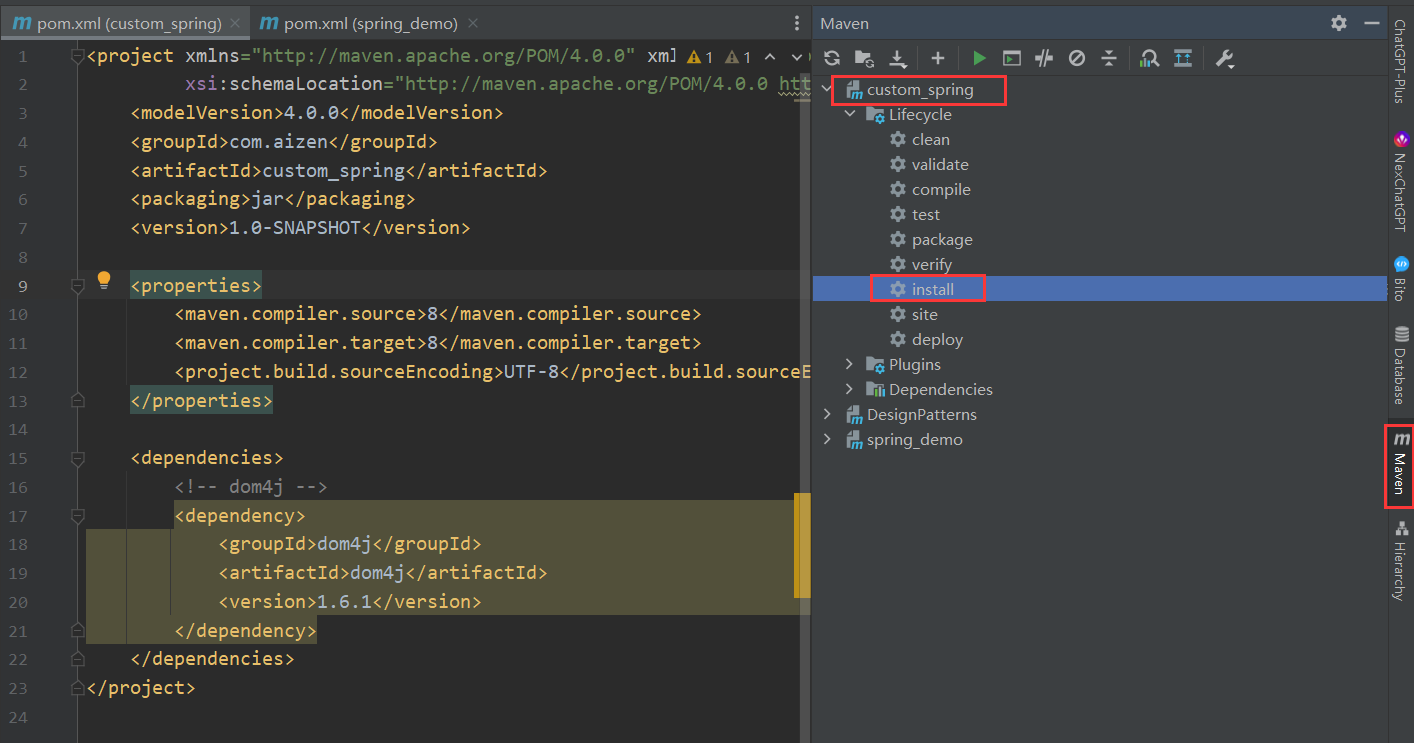

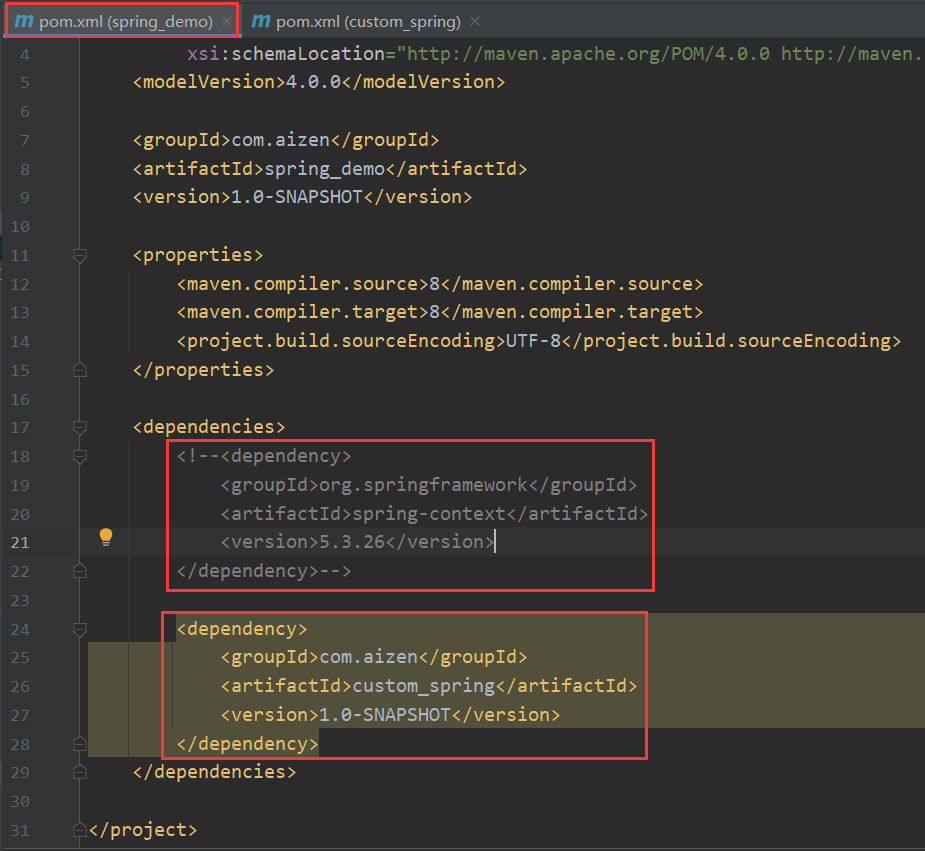
import com.aizen.framework.context.ApplicationContext;
import com.aizen.framework.context.support.ClassPathXmlApplicationContext;
import com.aizen.service.UserService;
// 控制层
public class UserController {
public static void main(String[] args) throws Exception {
// 创建Spring的容器对象(非延时加载)
ApplicationContext applicationContext = new ClassPathXmlApplicationContext("applicationContext.xml");
// 从ioc容器对象中获取userService对象
UserService userService = applicationContext.getBean("userService", UserService.class);
//调用userService方法进行业务逻辑处理
userService.add();
}
}
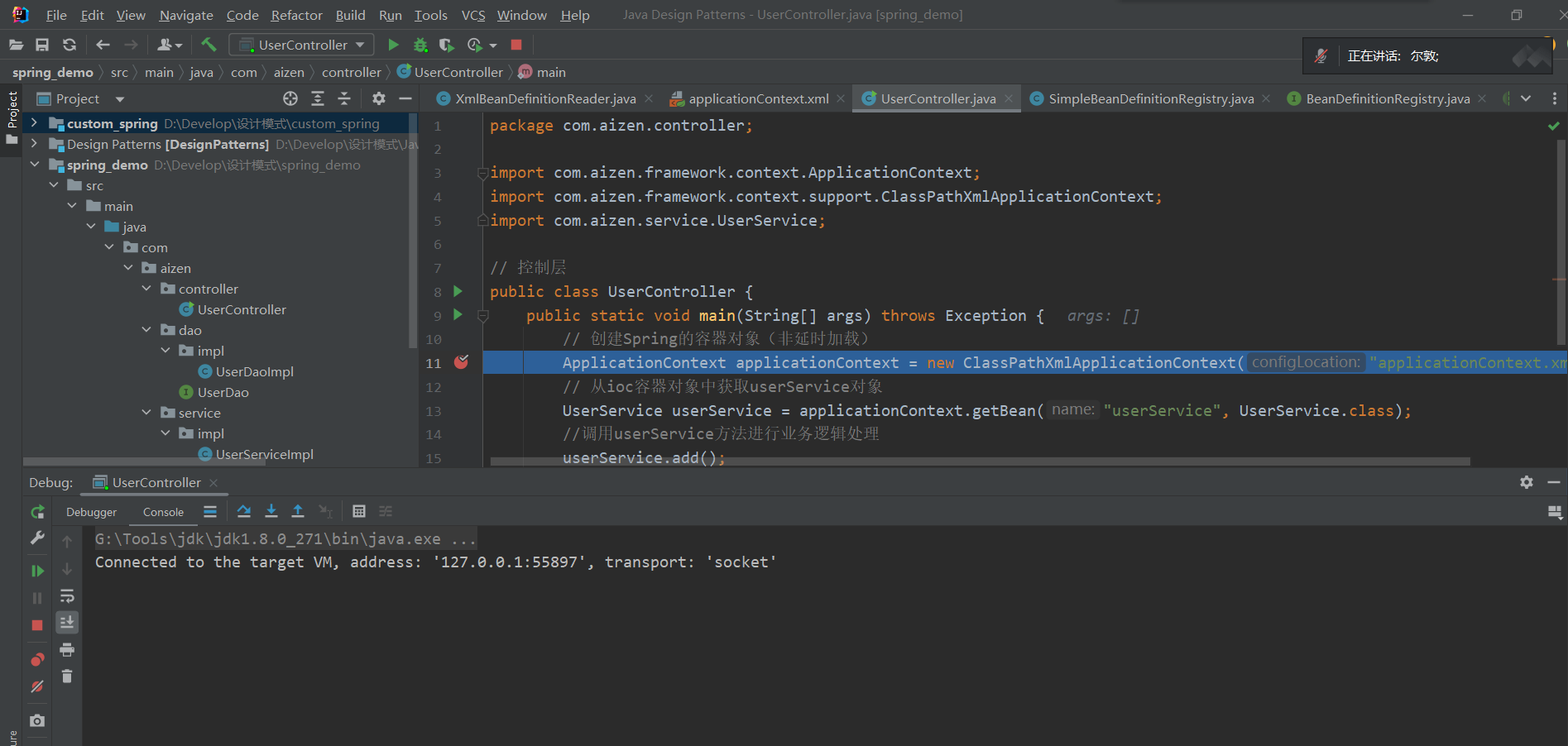
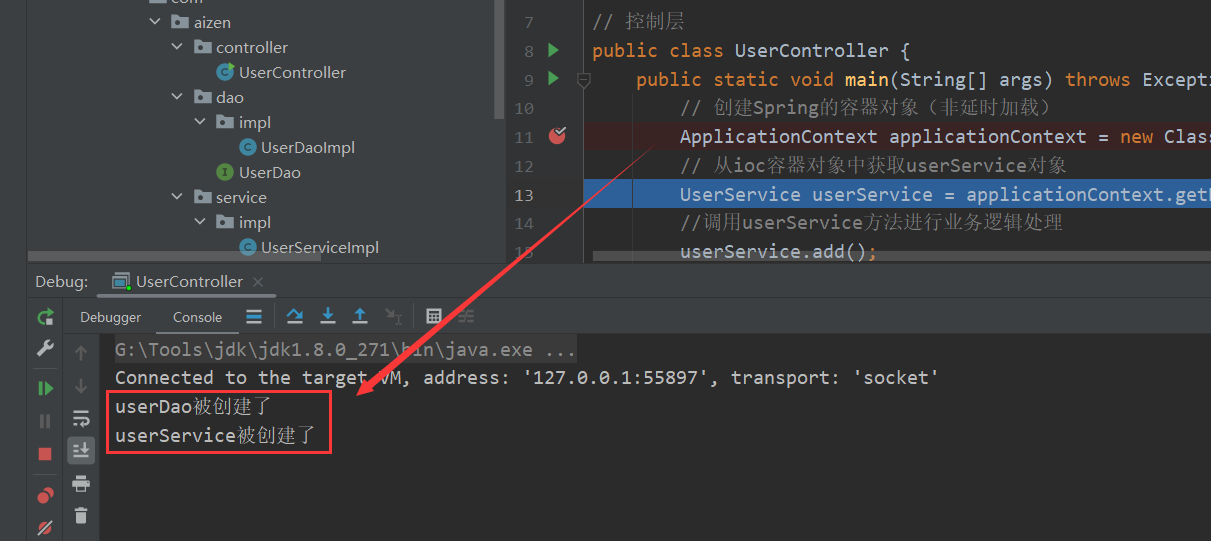
- 运行结果可以看到,userDao和userService对象都被创建了,说明IOC容器创建成功,Bean对象初始化并创建成功!并且userService调用add方法可以调用userDao的add方法,说明依赖注入成功!
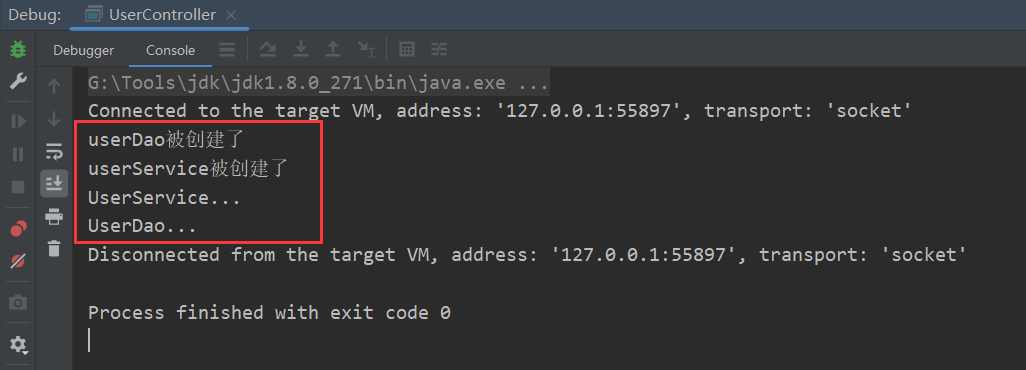
import com.aizen.dao.UserDao;
// 数据访问层实现类
public class UserDaoImpl implements UserDao {
private String username;
private String password;
// 提供set方法进行注入
public void setUsername(String username) {
this.username = username;
}
public void setPassword(String password) {
this.password = password;
}
public UserDaoImpl() {
System.out.println("userDao被创建了");
}
@Override
public void add() {
System.out.println("UserDao..." + username + " " + password);
}
}
<?xml version="1.0" encoding="UTF-8"?>
<beans>
<!-- IOC容器管理对象 -->
<bean id="userDao" class="com.aizen.dao.impl.UserDaoImpl">
<property name="username" value="zhangsan"/>
<property name="password" value="123456"/>
</bean>
<bean id="userService" class="com.aizen.service.impl.UserServiceImpl">
<property name="userDao" ref="userDao"/><!-- 依赖注入DI -->
</bean>
</beans>
- value属性注入String类型成功!实现了自定义依赖管理。
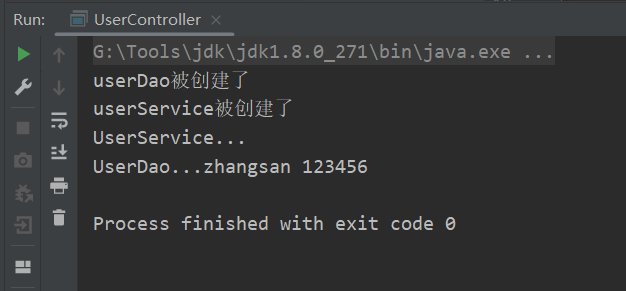
6、自定义Spring IOC总结
(1)使用到的设计模式
- 工厂模式。这个使用工厂模式 + 配置文件的方式。
- 单例模式。Spring IOC管理的bean对象都是单例的,此处的单例不是通过构造器进行单例的控制的,而是spring框架对每一个bean只创建了一个对象。
- 模板方法模式。AbstractApplicationContext类中的finishBeanInitialization()方法调用了子类的getBean()方法,因为getBean()的实现和环境息息相关。
- 迭代器模式。对于MutablePropertyValues类定义使用到了迭代器模式,因为此类存储并管理PropertyValue对象,也属于一个容器,所以给该容器提供一个遍历方式。
Spring框架其实使用到了很多设计模式,如AOP使用到了代理模式,选择JDK代理或者CGLIB代理使用到了策略模式,还有适配器模式,装饰者模式,观察者模式等。
(2)符合大部分设计原则
自行体会~~( ̄▽ ̄)”
(3)整个设计和Spring的设计还是有一定的出入
Spring框架底层是很复杂的,进行了很深入的封装,并对外提供了很好的扩展性。
而我们自定义SpringIOC有以下几个目的:
五、设计模式常见相关面试问题
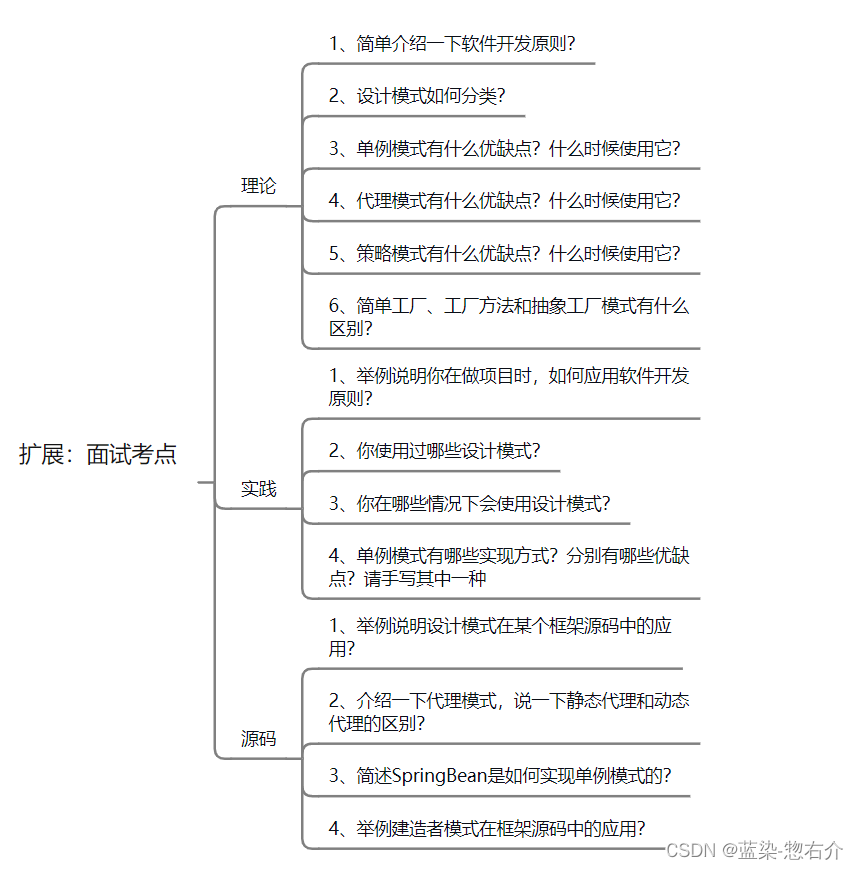
原文地址:https://blog.csdn.net/weixin_52152676/article/details/134692727
本文来自互联网用户投稿,该文观点仅代表作者本人,不代表本站立场。本站仅提供信息存储空间服务,不拥有所有权,不承担相关法律责任。
如若转载,请注明出处:http://www.7code.cn/show_10807.html
如若内容造成侵权/违法违规/事实不符,请联系代码007邮箱:suwngjj01@126.com进行投诉反馈,一经查实,立即删除!


